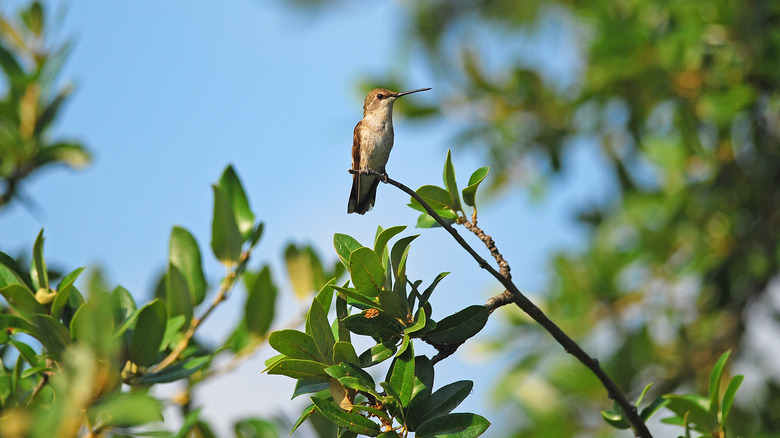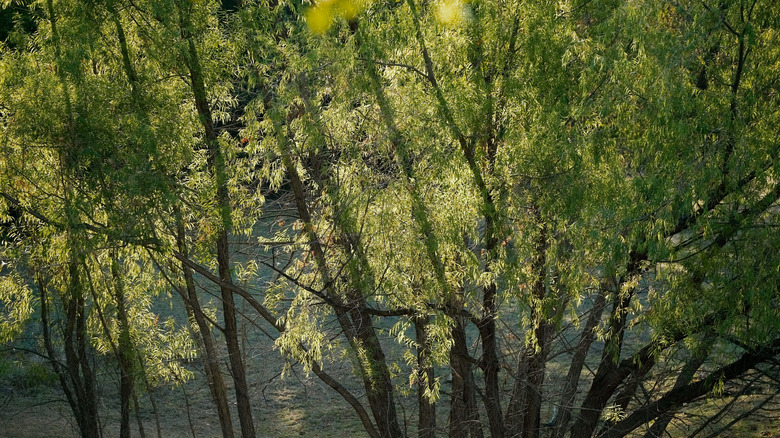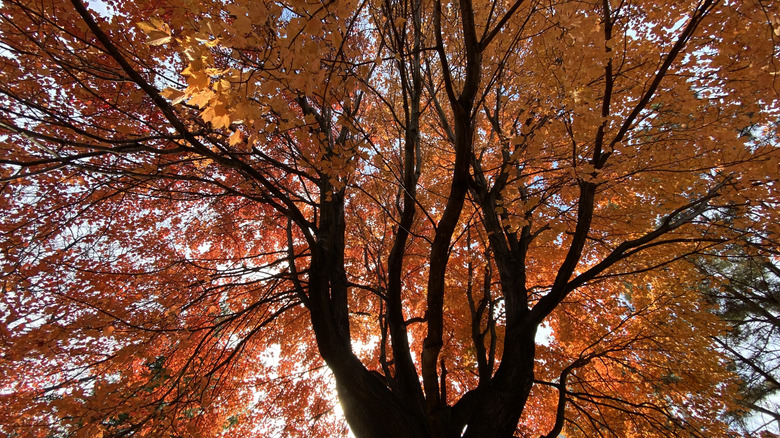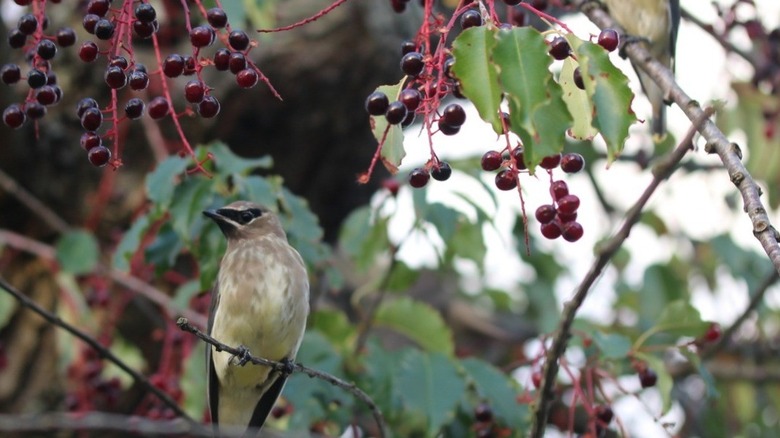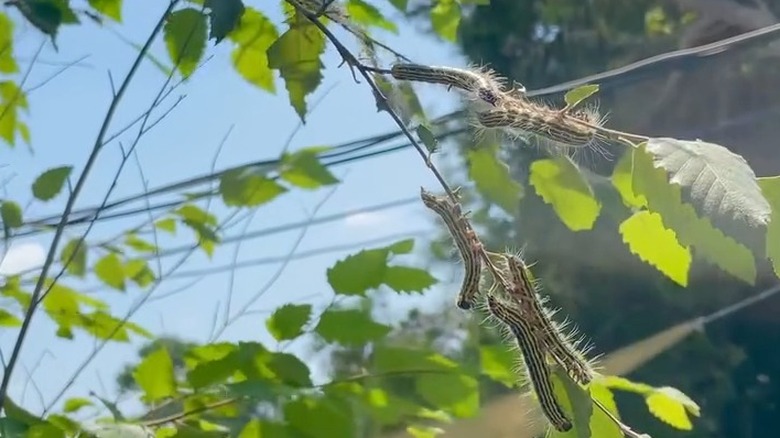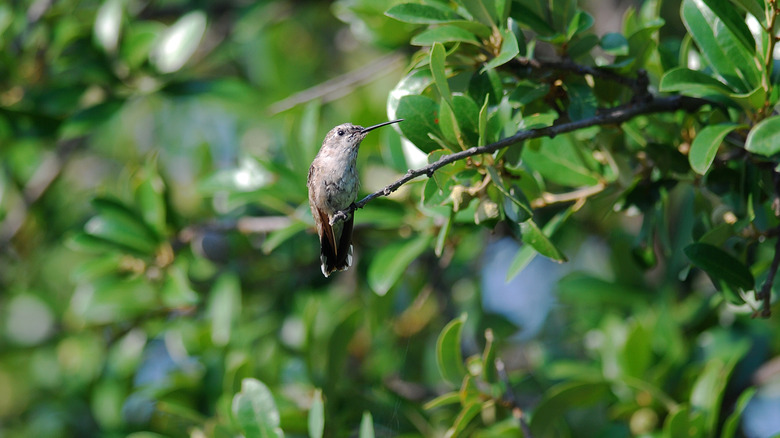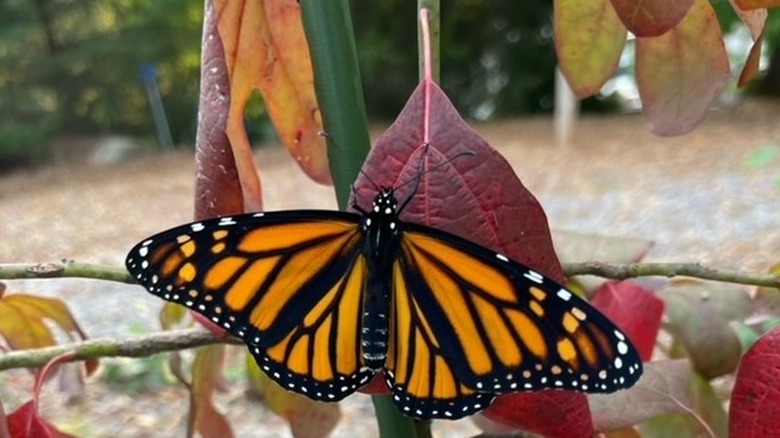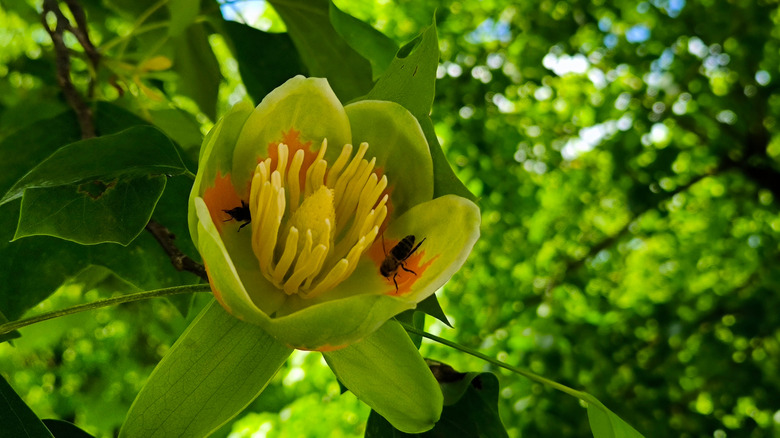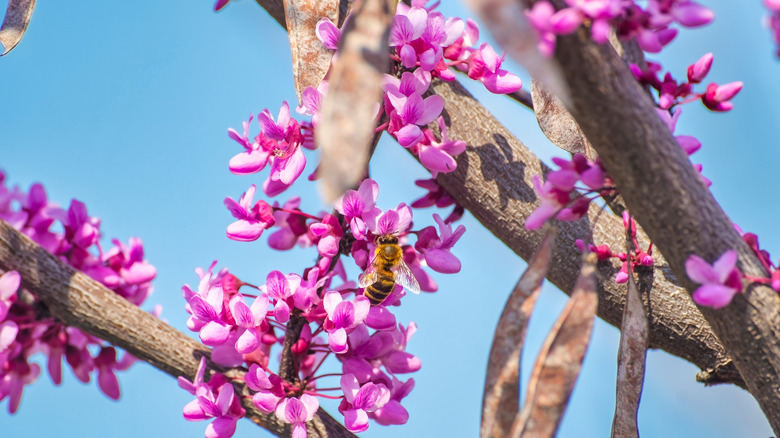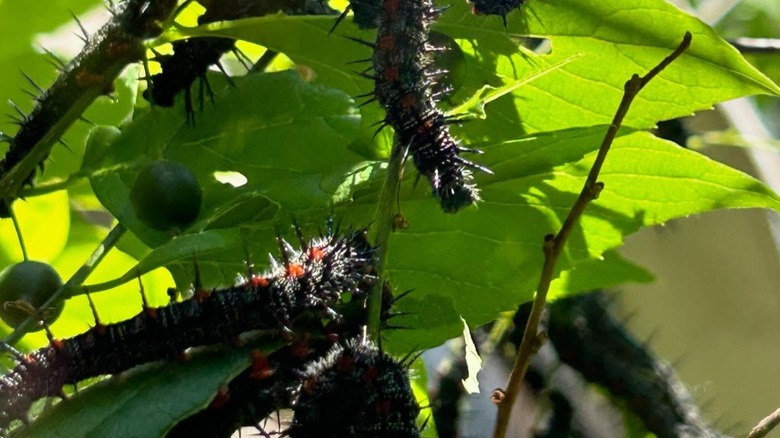9 Fast-Growing Trees That Will Make Your Yard A Pollinator Haven
More than 80% of plants rely on pollinators for fertilization and reproduction (via PennState's Centre for Pollinator Research). But with urbanization eating into their habitat, non-native plants and insects taking over and thriving in natural areas, and growing pesticide usage, pollinators are experiencing a disquieting drop in their populations. To arrest this decline, it's essential to grow plants that support your local pollinators. Fortunately, several flowering trees, such as black cherry, black willow, tulip poplar, red maple, river birch, live oak, sassafras, eastern redbud, and hackberry, can help. The best part, though? They all grow fast, so you won't have to wait too long to create a pollinator haven.
When planting for pollinators, you must look for options that meet their food and shelter needs. For the greatest impact, focus on trees that support native insects, such as bees, moths, butterflies, beetles, flies, and wasps, as they handle most of the pollination. Mixing in trees popular with pollinating birds, like orioles and hummingbirds, or small mammals like bats can also be impactful. Prioritize trees endemic to your region. This is because they're already well-adapted to the home conditions (and therefore can grow well there) and the native pollinators are familiar with their services. Now that we've established the key basics, here is the detailed discussion on the various fast-growing trees you may plant to get varied pollinators buzzing.
Black willow can add over 3 feet in a year, and attract scores of bees, butterflies, and other insect pollinators
Are you looking for a pollinator-friendly tree that will succeed in wet or flooded sites and keep soil erosion in check? Consider black willow (Salix nigra). Within a year of planting, young seedlings grow over 5 feet, and sometimes even 7-feet-tall. They remain vigorous later, too, gaining 3 to 4 feet each year, at least in the first two decades of their planting life.
Honeybees go after black willow's pollen and floral nectar as the cold season nears its end. Cuckoo, carpenter, halictid, and bumblebees are also drawn to their blooms. Willows also have a special relationship with andrenids (mining bees), as the blooms emerge at the same time as the bees. Several butterflies, such as eastern tiger swallowtail, acadian hairstreak, mourning cloak, red-spotted purple, viceroy, and eastern comma, rear their larvae on willow leaves. Numerous species of insect pollinators, including beetles, wasps, and flies, may similarly visit these trees. These deer-resistant trees also pull in beneficial insects, like syrphid flies.
Black willow trees are naturally found mostly in the eastern part of the U.S., from Minnesota to Texas, along with a limited presence in a few southwest states, including Arizona and California. But be careful with the site selection. Being weak-limbed, these trees are prone to ice or wind breakage. They also produce an extensive root system that can clog drainage lines if they're in the vicinity.
Red maples gain over 3 feet per year and are an early spring nectar source for honey bees (in addition to hosting several moth species)
Red maple (Acer rubrum) trees boast fiery blooms during the winter-spring transition and glorious foliage during the fall. Plus, these beauties grow fast. Planted in their desired conditions — moist soils with slightly acidic pH levels — they can gain an additional 3 feet on a yearly basis. They can be as tall as 70 feet by maturity.
Diverse pollinators seek red maple trees during different times of the year. Bees, including honey, cellophane, sweat, mining, osmia, and bumble, gather around their blooms during early spring. In contrast, moth caterpillars, such as imperial, cecropia, rosy maple, oval-based prominent, retarded dagger moth, maple looper, Baltimore bomolocha, inchworm, and orange-humped maple, will consume their leaves during the growth season, sometimes right up to October.
Red maples are widely distributed across the East Coast, and are cold hardy through Zone 2. However, ensure your area or woodland doesn't already have a high density of red maples before planting them. This is because they're being excessively planted today due to their visual appeal, reducing the overall plant diversity. Also, avoid growing them in lawns where they may get hit with a mower. Such hits can hollow out their thin bark and show signs that tree removal might be the right decision for your yard.
Black cherry trees gain up to 3 feet every year and bring in many pollinators, including bees, butterflies, and orioles
One fast-growing tree that pollinators and birds can't get enough of is black cherry (Prunus serotina). In their youth, these trees can grow up to 3 feet in height each year, provided you offer their favored cultural conditions. These include slightly acidic, fertile, moist (not inundated) soils with proper drainage and full sun exposure.
Black cherry trees produce fragrant, white flowers from April through May, attracting many bees and flies. These blooms also attract orioles. Although they're chaotic feeders, their eating habits are important for cross-pollination. Moreover, different butterflies, such as coral hairstreak, eastern tiger swallowtail, spring azure, viceroys, and red-spotted purple butterflies use their leaves for egg deposition year-round. In fact, nearly 430 caterpillar species feed on their foliage. Unfortunately, this list also includes tent caterpillars, the silk-weaving insects that strip the leaves of their nutrients, inducing defoliation. However, if bats are around in your area, they may make meals of tent caterpillars, and may indirectly aid in pollination. You may also find several moth species, such as promethea, banded tussock, small-eyed sphinx, wild cherry sphinx, and Columbia silk moth, humming around black cherry trees.
Although black cherry trees are North American natives, they tend to spread aggressively. While you might want to remove their suckers for containment, doing so can lower pollinator value. That's because several caterpillars overwinter on these stray seedlings.
River birch trees can grow up to 3 feet every year and feed over 400 different caterpillar species
River birch (Betula nigra) trees are naturally present around ravines, flood plains, and stream banks, succeeding well in heavy, clay, or intermittently wet soils. Indeed, they live longer on such sites, because dry conditions can lead to chlorosis and defoliation. But if you want them to grow faster — their typical range sits between 1 ½ to 3 feet yearly — you must maintain full sun exposure.
This fast-growing tree that provides natural shade for your yard also appeals to local pollinators. Many adult butterflies, such as mourning cloaks, eastern tiger swallowtails, and dreamy duskywings, feed on their pendant green flowers that arrive in early spring. They also use their foliage to lay eggs. In fact, over 400 different caterpillars munch on their green leaves. But don't forget to water these trees during summer, or they will prematurely drop their leaves. Keeping the roots mulched should also help retain moisture. River birches are native to the eastern U.S. region, specifically from Florida to Minnesota. Since they drop limbs and clutter the ground underneath, locate them at least 10 feet away from any hard structures.
Live oaks can grow 2 ½ feet each year and attract butterflies, moths, and hummingbirds
Known by several names, including bay live, plateau, and scrub oaks, live oaks (Quercus virginiana) are fast-growing trees you may grow for pollinator benefits. When young, they can gain nearly 3 feet annually. However, their growth will slow down as they mature, bringing the average down to about 2 to 2 ½ feet. To ensure they achieve the upper end of their growth rates, be sure to plant them in moist sites, as is common to coastal gardens. This will also limit their exposure to oak wilt disease.
Many pollinating butterflies, such as white-m hairstreak, banded hairstreak, Edward's hairstreak, gray hairstreak, Horace's duskywing, and juvenalis duskywing, spring for live oaks to deposit their eggs. Curiously, the larvae of red-banded hairstreaks feed on their shed leaves. Live oaks also host imperial and consular oakworm moths. Better still, hummingbirds help transfer their pollen, though you may not quite catch them in action, as live oaks can grow really tall.
Live oaks may become susceptible to insect galls, which may encourage honeybees to pay them attention. That's because some gall-causing parasitic wasps convert starches into sugar that these bees extract later. The bees may also steal the honeydew created by aphids, scales, and other sap-sucking insects harboring in live oaks. They're native to the southeast U.S. region, and are cold hardy through Zone 8.
Common sassafras trees can add about 2 feet per year and support many caterpillars and insect pollinators
Sassafras (Sassafras albidum) is a comparatively fast-growing tree, gaining about 2 feet every year. But the key to clocking these growth rates involves planting this unusual shade tree that smells like fruit loops and root beer in highly fertile soils with acidic pH levels. However, if you're dealing with poor soils, fertilize them in early spring when the tree leafs out, instead of during planting. Additionally, take steps to improve drainage if your garden soils tend to become saturated.
When sassafras trees burst out yellow blooms in spring, several adult butterflies, such as spicebush and pale swallowtail, flutter in for nectar. They also deposit their eggs on the tree's foliage along with palamedes and tiger swallowtails. Overall, sassafras trees accommodate 36 distinct caterpillar species. Aside from butterflies, numerous moths, including promethea silkmoth, tulip-tree beauty, and imperial, seek their flowery nectar. Insect pollinators like beetles, bees, flies, and wasps also call on these trees.
Sassafras trees are endemic to several states in the eastern U.S. region, where gardeners could benefit from their heat and drought tolerance. Be cautious about their site location, because such trees can be allelopathic and may impair the growth of abutting vegetation. You must also prune suckers regularly and keep an eye out for the fatal laurel wilt disease.
Tulip poplar grows up to 3 feet per year and produces abundant nectar-rich flowers that attract honey bees, beetles, and hummingbirds
If your yard can handle large trees, give tulip poplars (Liriodendron tulipifera) a chance. Not only are these trees beautiful, but they establish quickly, too. In the right site, expect them to add another 2 to 3 feet every year. They grow faster when they receive ample rainfall and are sited in deep, highly fertile soils.
Like black willows, tulip poplars are quite the sought-after tree for honeybees and bumblebees when they venture out in search of pollen in early spring. By planting this gorgeous tree, you even get to watch hummingbirds flock to your yard for the saccharine nectar seeping down the orange blooms. Sometimes, even cedar waxwings drop their berry preferences, sipping on the flowery sap. Nearly 20 caterpillars, including eastern tiger and spicebush swallowtail butterflies, take up residence in their canopies. Other insect pollinators, such as flies and beetles, also collect around tulip poplars. Tuliptree silkmoths' larvae primarily consume their foliage.
Tulip poplars are indigenous to various parts of the eastern and north-central U.S. Newly transplanted trees, or even mature trees, may drop leaves as a response to extreme summer heat and drought stress. Their fast growth comes at the price of weak wood, so site them where you wouldn't mind the limbs coming loose during storms. Else, grow them in a sheltered location.
Eastern redbuds grow rapidly in early years, then nearly 2 feet every year after, and provide critical early-season nectar for bees
Eastern redbuds (Cercis canadensis) might not be the fastest trees throughout their life, but they're fast when it counts. As younglings, they can grow nearly 10 feet tall in a span of six years or less. Planting them young is favored, as they develop deep taproots that don't take well to transplantation. However, to reach these growth rates, you must site them in a naturally fertile and moist location. Otherwise, ensure that you water and fertilize them generously in less-than-optimal locations, or they won't grow as rapidly. Bear in mind that redbuds will eventually moderate their growth to about 2 feet per year, topping out at about 30 feet, or in some cases, 40 feet.
Since eastern redbuds are one of the earliest flowering trees to bloom in spring, they're a critical food resource for many bee species becoming active around this time. From native bees like mason, long-horned, cuckoo, southeastern blueberry, and bumblebees, to exotic honeybees, you'll find them buzzing around redbuds and thirsting over their flowers' delicious nectar. It's during such acts that they move pollen. Apart from bees, nearly 19 butterfly species, including Henry's elfin butterflies, visit redbuds for egg-laying. If you're planning to add these show-stopping pink trees to your yard that birds also love to visit, albeit without any pollination benefits, ensure you're in zone 4 through 9. These trees are endemic to the eastern and central U.S.
Hackberry gains 2 feet every year and hosts 41 butterfly species on its foliage
When common hackberry (Celtis occidentalis) trees are given optimal conditions, they can grow over 2 feet annually. So, to maximize their growth rates, locate them in moist, rich soils with good drainage. This way, they might tower 30 feet high by the end of a decade. While you can grow them in tricky dry spots to take advantage of their wide adaptability, it'll slow down their growth.
About their pollinator benefits: Hackberries are known to host about 41 different caterpillars on their green leaves. American snout-nosed, question mark, and mourning cloak are common visitors who seek their flowers early in the spring when little else is in bloom. While they also attract specialized butterflies, like hackberry and tawny emperors, these species rarely move the pollen, as they prefer to nectar at the tree's sap, mud, or rotting fruit.
That being said, hackberries are best grown in their native range, which lies between New England and South Dakota. As they're keen on sending volunteer seedlings, you'll need to stay on top of pruning. Otherwise, grow them in an area where you don't mind them outstripping boundaries.
